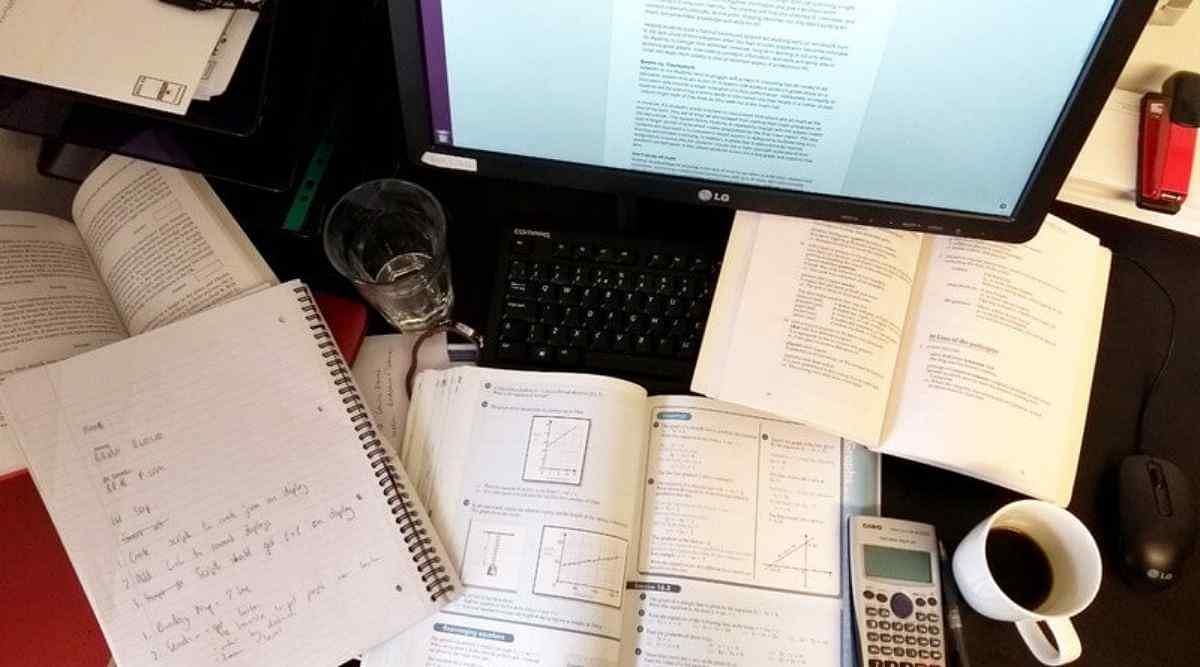Matter reacts in a certain specific way when it comes in contact with magnetism. Magnetism and matter is an important chapter in Physics.
Table of Contents
Magnetism and Matter are one of the most important chapters in the CBSE Class 12 Physics subject. Matter reacts in a certain specific manner when it is exposed to magnetism. The presence of a magnetic field itself leads to the formation of various magnetic materials. More details on Magnetism and Matter have been covered in this article.
Also Check: NCERT Books - PDF Format for Classes 1 to 12
Magnets and Their Properties
A magnet is a substance that generates a magnetic field which is an invisible force that attracts or repels other ferromagnetic elements such as iron, steel, nickel, cobalt, etc. Find below some of the properties of magnets:
- Magnets attract ferromagnetic materials such as iron, cobalt, and nickel.
- The magnet's similar poles repel each other, whereas the opposite poles attract one other.
- A freely suspended magnet always comes to rest facing north-south.
- Magnet has two poles - The south pole and the North pole and the 2 poles of a magnet cannot be isolated.
- The magnet's poles are arranged in pairs. i.e. magnetic monopole doesn't exist.
Also Check: NCERT Books for Class 12 Physics
Magnetic Properties of Materials
Magnetic properties of all materials except for diamagnetism occur due to the interactions of unpaired electrons. Magnetic materials are classified into three categories namely paramagnetic, diamagnetic, and ferromagnetic. The five magnetic properties of materials are listed below:
- Intensity of Magnetisation (I): The electrons moving around the nucleus have a magnetic moment. When the material is not magnetised, the magnetic dipole moment is zero. When the material is kept in an external magnetic field, the magnetic moments are aligned in a particular direction and the material obtains a net non-zero dipole moment. The net dipole moment per unit volume is known as magnetization or intensity of magnetisation.
- Magnetic Field (H) or Magnetic Intensity: The magnetic field produced only by the electric current flowing in a solenoid is called magnetic intensity which s the external magnetic field that induces magnetic property in a material.
- Magnetic Susceptibility: A material gets magnetised when it is placed in an external magnetic field. For a small magnetising field, the intensity of magnetisation (I) obtained by the material is directly proportional to the magnetic field (H).
I ∝ H
I = χmH, χm is the susceptibility of the material
- Retentivity: The retentivity of a material is defined as its ability to retain or resist magnetization.
- Coercivity: The coercivity of a material is its ability to withstand the external magnetic field without becoming demagnetised.
Permanent Magnets and Electromagnets
Permanent magnets always display magnetic behaviour. They are made up of a magnetic material and have their own magnetic field. An electromagnet can have a magnetic field only when electric current flows through it and the magnetic field disappears when the current flow stops. Tabulated below are some of the other differences between permanent magnets and electromagnets:
|
Permanent Magnet |
Electromagnet |
|
Displays magnetic properties when the material is magnetised |
It displays magnetic properties when current is passed through it |
|
Its strength is dependent upon the nature of the material used in its creation |
The strength is adjusted according to the amount of current flow |
|
Cannot be used once its magnetic properties are lost |
Removal of magnetic properties is temporary |
|
Does not require a continuous supply of electricity to maintain its magnetic field |
A continuous supply of electricity is needed to maintain its magnetic field. |
|
It is usually made of hard materials |
It is usually made of soft materials |
|
The two poles of a permanent magnet cannot be changed. |
The two poles of an electromagnet can be altered with the flow of current |
Magnetisation and Magnetic Intensity
In any magnetic field, magnetisation, also known as magnetic polarisation, is a vector number that measures the intensity of a persistent or induced dipole moment. Magnetic intensity is the force that a magnet’s poles experience in a magnetic field.
A bar magnet attracts objects made up of iron to its poles, which are the magnet’s ends. The north pole is located at one end whereas the south pole is located at the other end. The force exerted by magnets causes magnetism, which produces magnetic fields that attract or repel other metallic things. The density of magnetic dipole moments induced in a magnetic substance when it is placed close to a magnet is known as magnetisation.
The magnetic effects can also be generated by passing an electrical current through the material. The effect of magnetism is caused by electron mobility in atoms or the spinning of electrons/nuclei which is caused by electrically charged particles. The quantity of charge, the particle’s velocity, and the strength of the field all have an effect on the force exerted on electrically charged particles in a magnetic field. As per the laws of magnetism:
- Same poles repel each other
- Opposing poles are attracted to one another
The Earth's Magnetism
The Earth's magnetic field is caused by electric currents in the liquid outer core and its core is hotter than 1043 K, the Curie point temperature, above which the orientations of spins within iron become randomized. The Earth's magnetic field intensity is somewhere between 25,000 - 65,000 nT (. 25 - . 65 gausses).
A bar magnet points in the north-south direction due to the influence of the earth’s gigantic magnetic field. It is believed that the earth’s magnetic field is formed due to the electric currents circulating from the earth’s core to space. This magnetic field saves the earth from the solar wind which could otherwise strip away the ozone layer of the earth. The SI unit of the earth’s magnetic field is Tesla.

Theory of Earth’s Magnetism
There is no solid reason for the cause of earth’s magnetism. However, there are a few theories that revolve around the Earth’s magnetism some of which are mentioned below:
- The Dynamo Effect: The outer core of the earth consists of molten iron and other heavy elements in liquid form. The inner core of the earth solidifies due to gravity. Therefore, the motion of metallic fluids in the outer core of the earth causes an electric current due to which the earth gets its own magnetic field lines.
- Ionization of the Outer Layers: This theory explains that due to the rotation of the earth on its own axis, a strong electric current is produced, as a result of the ionization of the outer layers of the earth. This in turn produces magnetism due to the movement of the ions but the magnetic field will be very weak. The Dynamo Effect is the more acceptable theory of earth’s magnetism.
The Bar Magnet
A bar magnet is a rectangular object that shows permanent magnetic properties and is made up of iron, steel or any other ferromagnetic substance or ferromagnetic composite. It has two poles, namely a north pole and a south pole. When suspended freely, the magnet aligns itself in such as way that the northern pole points towards the magnetic north pole of the earth.
Types of Bar Magnets
More details about the two types of bar magnets are given below:
- Cylindrical bar magnet: A cylindrical rod, also known as a rod magnet, has a thickness larger than the diameter enabling high magnetism property. These bar magnets are used for educational, experimental, and research purposes.
- Rectangular bar magnet: Rectangular bar magnets are used in the manufacturing and engineering industries as they have greater magnetic strength and field as compared to other magnets.
Properties of Bar Magnet
The properties of a bar magnet are similar to any permanent magnet.
- It has a north pole and a south pole at its two ends. Even if the bar magnet is cut into two equal halves, the two pieces will still have a north pole and a south pole, irrespective of how many pieces it is broken into.
- Its magnetic force is the strongest at the poles.
- If a bar magnet is suspended freely in the air with a thread, it will not come to rest until the poles are aligned in a north-south position. A Mariner’s Compass determines direction using this property.
- If two bar magnets are held close to each other, their unlike poles will attract and their like poles will repel each other.
- A bar magnet will attract all ferromagnetic materials such as iron, nickel and cobalt.

FAQS on Magnetism and Matter
Q1: What do you understand by magnetic dipole?
Ans: In electromagnetism, a magnetic dipole is the impact of the movement of electrons around an atomic nucleus. The magnetic dipole moment is the strength exerted by the movement of such electrons and is used in the measurement of the tendency of an object in interacting with an external magnetic field.
Q2: What is the principle in Biot Savart Law?
Ans: The principle underlying Biot Savart Law states that the value of a magnetic field at any given point of time is dependent on all the factors that influence the magnetic field. It shows that the impact is determined by the length, magnitude, direction, as well as proximity to the electric current.
Q3: What are the different types of magnetic material?
Ans: The three different types of magnetic material are paramagnetic material, diamagnetic material, and ferromagnetic material. Paramagnetic materials show weak magnetism, and ferromagnetic materials show strong magnetism. However, both of these materials are in the direction of a magnetic field whereas diamagnetic material is in the opposite direction of a magnetic field.
Q4: Describe some of the characteristics of magnetic field lines.
Ans: Some of the characteristics of magnetic field lines are listed below:
- The bisection of magnetic field lines is not possible. If an attempt is made to do so, there will be two directions of the magnetic field which is impossible.
- The magnetic force of lines is formed as closed loops.
- The magnetic field’s direction is the tangential line drawn at any point on it.
- The area having denser magnetic field lines is known to have a stronger magnetic field and vice versa.
Q5: What are the elements of Earth's magnetism?
Ans: The elements of Earth’s magnetism are:
- Angle of Inclination: The angle of inclination is defined as the angle between the horizontal line of the magnetic meridian and the direction of the total intensity of the magnetic field.
- Angle of Declination: The angle of declination is defined as the angle between the geographic meridian and the magnetic meridian.
- Horizontal component: Horizontal component is the component of the total intensity of the earth’s magnetic field in the horizontal direction.
Q6: Illustrate a few properties of the bar magnet.
Ans: A few properties of the bar magnet are given below:
- Poles: Unlike poles of a bar magnet attract each other and like poles repel each other.
- Attraction: Bar magnets attract materials such as cobalt and iron. This property is the least in the centre and maximum at the poles.
- Strength of the pole: It is the ability of a bar magnet to attract magnetic materials. Both the north and south poles have equal pole strength.
- Directional property: All bar magnets align in a north-south direction when suspended freely.
Q7: Define the following terms:
- Magnetic Axis
- Geographic Axis
- Magnetic Equator
Ans: All of the above terms are related to the Earth's magnetic field. The definition of the above-mentioned keywords are shown below:
- Magnetic Axis: A magnetic axis is an imaginary line joining the magnetic poles of the Earth.
- Geographic Axis: A geographic axis is a line joining the geographic poles of the Earth.
- Magnetic Equator: A magnetic equator, also known as a geomagnetic equator, is an imaginary circle on the surface of the Earth that is perpendicular to the magnetic axis.


























POST YOUR COMMENT